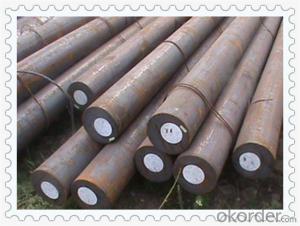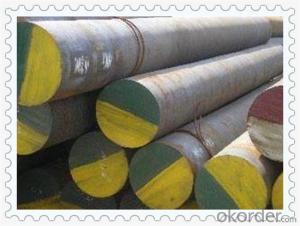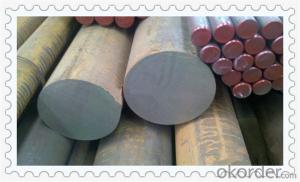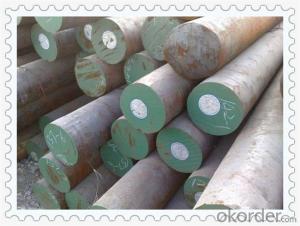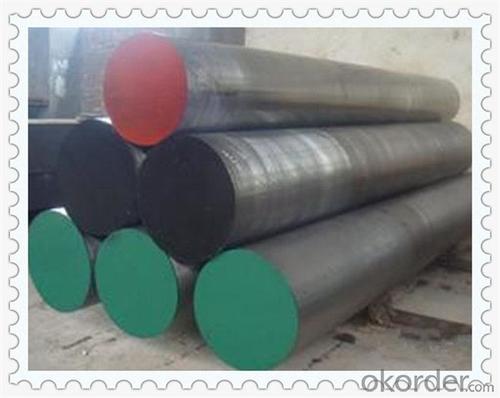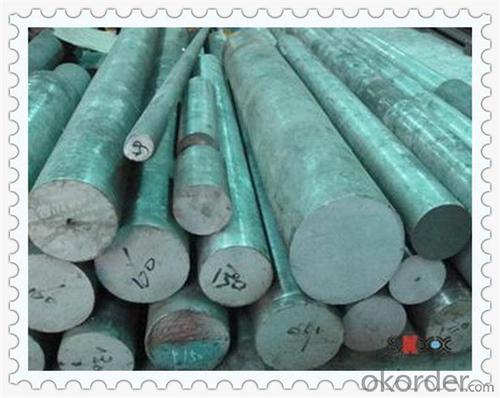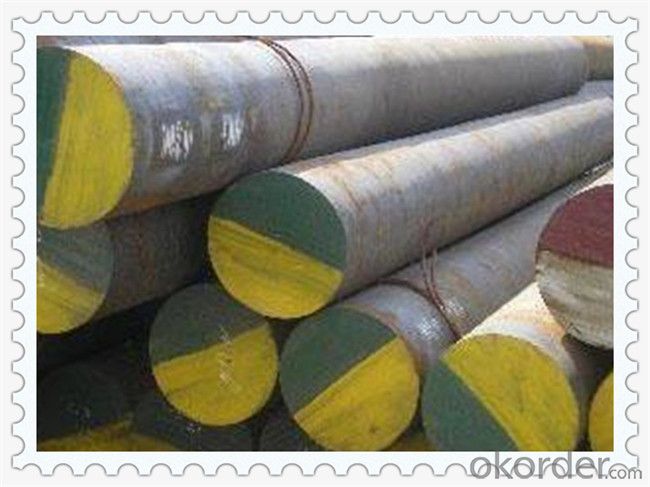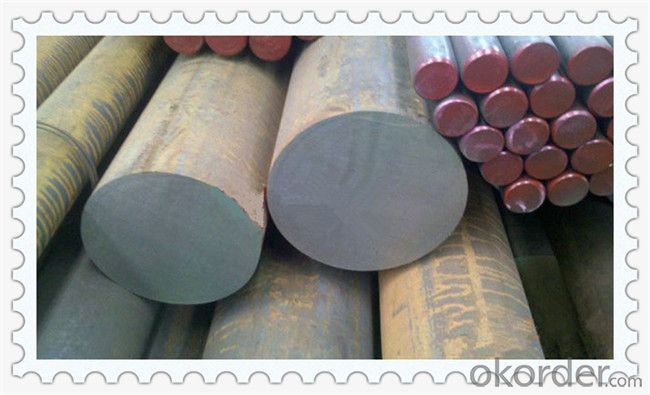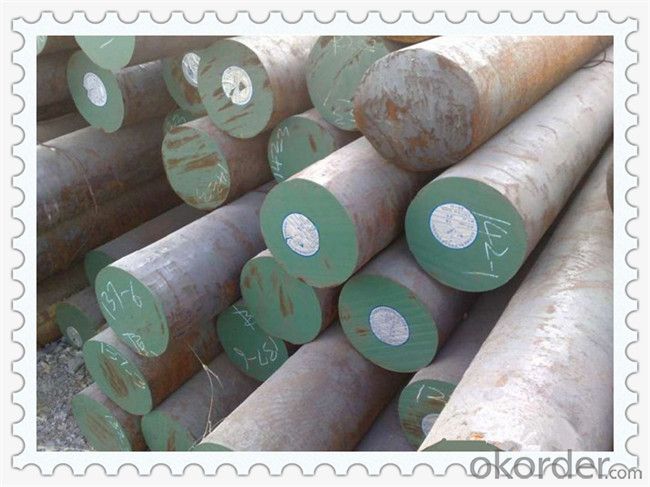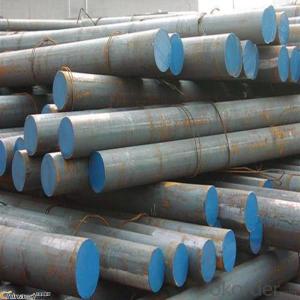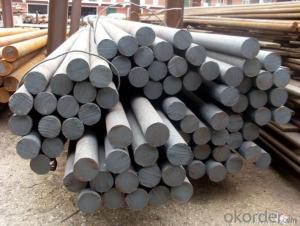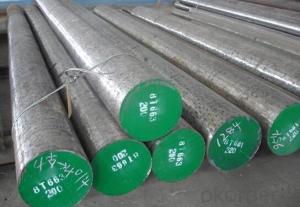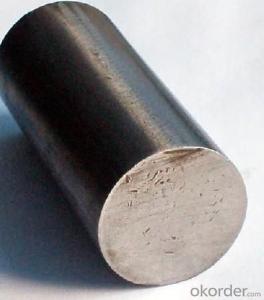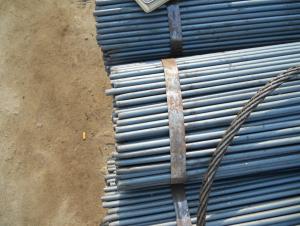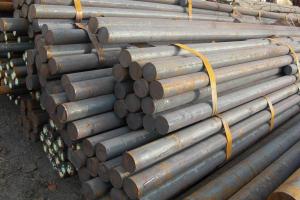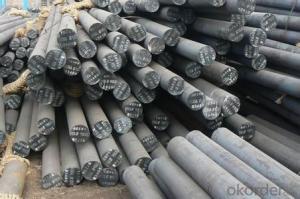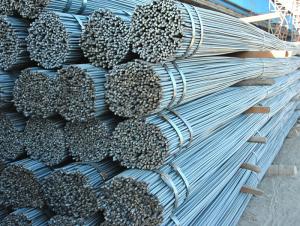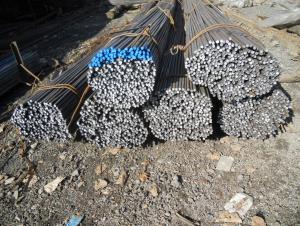4130 4140 4150 20MnCr5 42CrMo4 8620 4340 Alloy Round Steel Bar
- Loading Port:
- China main port
- Payment Terms:
- TT OR LC
- Min Order Qty:
- 30 m.t.
- Supply Capability:
- 10000 m.t./month
OKorder Service Pledge
OKorder Financial Service
You Might Also Like
4130 4140 4150 20MnCr5 42CrMo4 8620 4340 Alloy Round Steel Bar
Products Details
4130 4140 4150 20MnCr5 42CrMo4 8620 4340 alloy steel round bar
1. Grade: AISI 1045, SCM440, 42CrMo, 40Cr.
2. Size: 25-450m
4130 4140 4150 20MnCr5 42CrMo4 8620 4340 alloy steel round bar
Grade: | S45CB, 40Cr, SCM440, SCM420, 42CrMo, AISI4140, customized is available. |
| Size: | 25-450mm |
| Length: | 5.8m/6m fixed length, or as customized. |
| MOQ: | 20MT |
| Remark: | chamfering and straightness |
| Packing: | arround 3MT per bundle |
Chemical Composition (%)
Grade | C | Si | Mn | P | S | Cr | Mo |
42CrMo4 | 0.38-0.45 | 0.17-0.37 | 0.40-0.70 | ≤0.035 | ≤0.035 | 0.90-1.20 | 0.15-0.25 |
1.7225 | 0.38-0.45 | ≤0.40 | 0.60-0.90 | ≤0.025 | ≤0.035 | 0.90-1.20 | 0.15-0.30 |
4140 | 0.38-0.43 | 0.15-0.35 | 0.75-1.00 | ≤0.035 | ≤0.040 | 0.80-1.10 | 0.15-0.25 |
Products Show
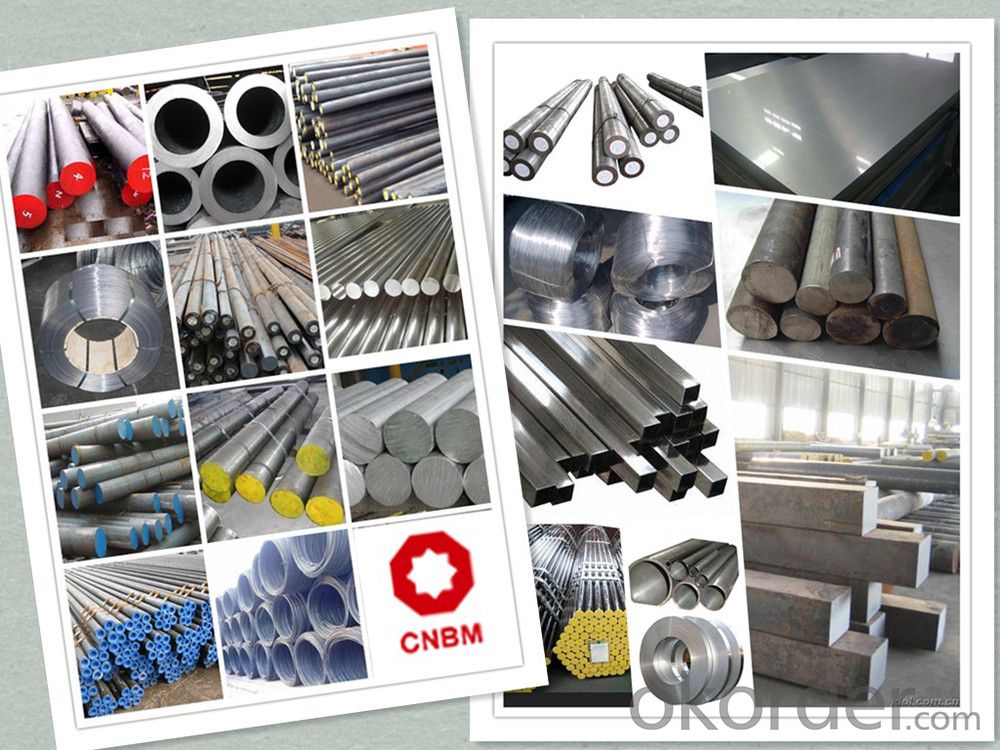
Product Overviews
| Product Name | Typical Grades | Diameter(mm) | Standard adopted |
| Carbon Steel | 20 (1020/S20C/C22) | Ø16-Ø300 |
GB/SAE/JIS/DIN
|
| 40 (1040/S40C/C40) | |||
| 45 (1045/S45C/C45) | |||
| Bearing Steel | GCr9 (51100/SUJ1) | Ø12-Ø250 | |
| GCr15 (52100/SUJ2/100Gr6) | |||
| GCr9SiMn (A485-Gr.1/SUJ3) | |||
Cr-Mo Steel | 20Cr (5120/SCr420H/20Cr4) | Ø12-Ø250 | |
| 40Cr (5140/SCr440/41Cr4) | |||
| 42CrMo(4140/SCM440/42CrMo4) | |||
| Gear Steel | 20CrNiMo | Ø16-Ø600 | |
| 20CrMn(5115/SMnC420/20MnCr5) | |||
| 20CrNiMo(8620/SNCM220/20CrMiMo2) |
Application
| Carbon Steel | Mold bottom, Plastic mold, Construction machinery parts Automobile parts, Security grills, Screens, Construction |
| Bearing Steel | Aerospace, Navigation, Nuclear energy, Chemical industry Electronic information, Petrochemical, Instrument and meter Transportation |
| Cr-Mo Steel | Mechanism & Fasteners gear, Stressed components for vehicles Engines and machines, Parts of larger cross-section |
| Gear Steel | All kinds of gears, Statically and dynamically stressed component for vehicles Engines and machine, Larger cross-section parts, Crankshafts |
Work Shop

Company Information
CNBM International Corporation is the most important trading platform of CNBM group.
Whith its advantages, CNBM International are mainly concentrate on Cement, Glass, Iron and Steel, Ceramics industries and devotes herself for supplying high qulity series of refractories as well as technical consultancies and logistics solutions.

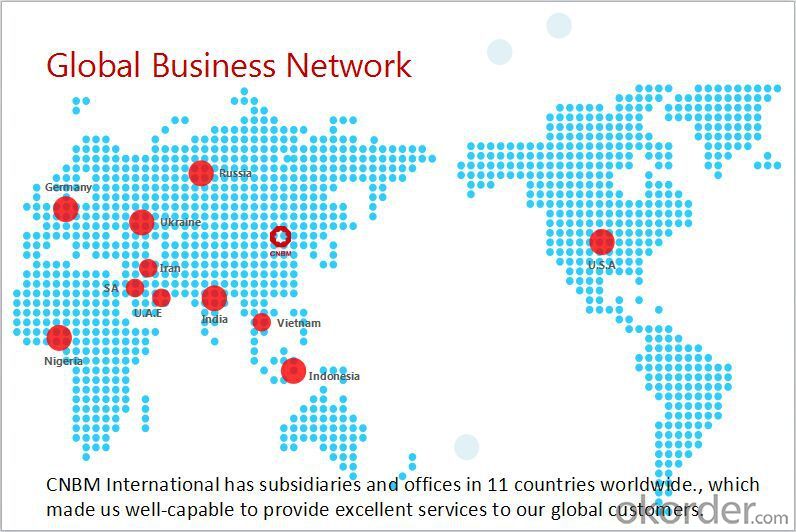
FAQ
1, Your advantages?
professional products inquiry, products knowledge train (for agents), smooth goods delivery, excellent customer solution proposale
2, Test & Certificate?
SGS test is available, customer inspection before shipping is welcome, third party inspection is no problem
3, Factory or Trading Company?
CNBM is a trading company but we have so many protocol factories and CNBM works as a trading department of these factories. Also CNBM is the holding company of many factories.
4, Payment Terms?
30% TT as deposit and 70% before delivery.
Irrevocable L/C at sight.
5, Trading Terms?
EXW, FOB, CIF, FFR, CNF
6, After-sale Service?
CNBM provides the services and support you need for every step of our cooperation. We're the business partner you can trust.
For any problem, please kindly contact us at any your convenient time.
We'll reply you in our first priority within 24 hours.
Packaging & Delivery
1, Packaging: seaworthy package or as required
2, Delivery: 35-45 days or based on quantity
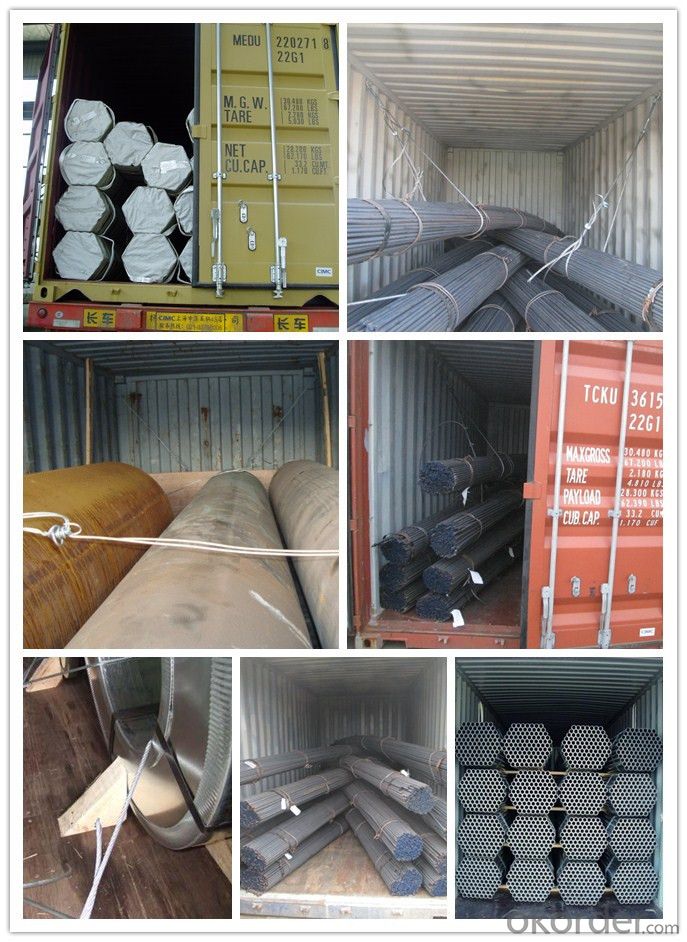
- Q: What are the different types of steel round bar profiles?
- There are several different types of steel round bar profiles, including solid round bars, hollow round bars, and threaded round bars.
- Q: What are the different heat treatment processes for steel round bars?
- There are several heat treatment processes for steel round bars, including annealing, normalizing, quenching, tempering, and hardening. Annealing involves heating the steel to a specific temperature and then slowly cooling it to relieve internal stresses and improve its machinability. Normalizing is a similar process, but the cooling is done in still air to achieve a more uniform structure. Quenching involves rapidly cooling the steel from a high temperature to increase its hardness, while tempering is a subsequent process that reduces the brittleness caused by quenching through controlled reheating. Hardening is a process that involves heating the steel to a high temperature and then rapidly cooling it to achieve maximum hardness.
- Q: How do I choose the right grade of steel round bar for my application?
- Choosing the right grade of steel round bar for your application requires careful consideration of several factors. Here are some steps to help you make an informed decision: 1. Determine the application requirements: Start by understanding the specific demands of your application. Consider factors such as load-bearing capacity, corrosion resistance, temperature resistance, and any specific industry standards or regulations that may apply. 2. Identify the required mechanical properties: Depending on the application, you may need specific mechanical properties such as strength, hardness, toughness, or ductility. Identify the required values for these properties and prioritize them based on their importance to your application. 3. Consider the environmental conditions: Evaluate the conditions in which the steel round bar will operate. This includes factors such as exposure to moisture, chemicals, high temperatures, or abrasive environments. Some grades of steel are more resistant to corrosion or heat, making them more suitable for specific conditions. 4. Consult with experts: If you are unsure about the best grade of steel for your application, seek advice from professionals such as metallurgists, engineers, or suppliers. They can provide valuable insights based on their expertise and experience. 5. Compare different grades: Once you have a clear understanding of your application requirements, research and compare different grades of steel round bars available on the market. Consider factors such as composition, manufacturing process, and specific properties of each grade. Look for grades that closely match your requirements. 6. Review industry standards and specifications: Check if there are any industry standards or specifications that dictate the use of specific grades for your application. These standards can provide guidance and ensure compliance with safety and quality requirements. 7. Evaluate cost-effectiveness: Evaluate the cost-effectiveness of different grades by considering factors such as initial purchase cost, maintenance and replacement costs, and the overall lifespan of the steel round bar. 8. Conduct tests and trials: If possible, conduct tests or trials using different grades of steel round bars to assess their performance in your specific application. This can provide valuable data and help you make a more informed decision. By following these steps and considering all relevant factors, you can choose the right grade of steel round bar that will meet the demands of your application efficiently and effectively.
- Q: Can steel round bars be used for construction purposes?
- Yes, steel round bars can be used for construction purposes. They are commonly used for structural applications such as building frames, bridges, and various types of infrastructure due to their strength, durability, and versatility. Steel round bars provide a reliable and cost-effective solution for construction projects.
- Q: How do steel round bars compare to rubber round bars?
- Steel round bars and rubber round bars are two very different materials with distinct properties and applications. Steel round bars, made from hardened carbon steel, are known for their strength and durability. They have a high tensile strength and can withstand heavy loads and stress without deforming or breaking. Steel round bars are commonly used in construction, engineering, and manufacturing industries for structural support, reinforcement, and various mechanical applications. They are also highly resistant to heat and corrosion, making them suitable for applications in extreme conditions. On the other hand, rubber round bars are made from synthetic or natural rubber compounds. Rubber round bars offer unique advantages such as flexibility, elasticity, and vibration dampening properties. They are commonly used in applications where shock absorption, noise reduction, or sealing properties are required. Rubber round bars find applications in automotive industries, machinery mounts, conveyor systems, and various other industrial applications where their unique properties are beneficial. While steel round bars offer exceptional strength and rigidity, rubber round bars provide flexibility and vibration dampening capabilities. The choice between steel and rubber round bars primarily depends on the specific requirements of the application. If the application demands high strength and durability, steel round bars are the preferred choice. Conversely, if the application requires flexibility, elasticity, or vibration dampening, rubber round bars are more suitable. In summary, steel round bars and rubber round bars have different properties and applications. Steel round bars offer strength and durability, while rubber round bars provide flexibility and vibration dampening properties. The choice between the two depends on the specific requirements of the application.
- Q: What are the advantages of using nickel-tungsten alloy steel round bars?
- There are several advantages of using nickel-tungsten alloy steel round bars: 1. High strength and durability: Nickel-tungsten alloy steel round bars have excellent strength and durability properties. This makes them suitable for applications that require resistance to wear, fatigue, and high-temperature environments. 2. Corrosion resistance: The addition of nickel in the alloy enhances its corrosion resistance properties. This makes nickel-tungsten alloy steel round bars highly resistant to various corrosive environments, including acids, alkalis, and seawater. 3. Excellent heat resistance: Nickel-tungsten alloy steel round bars exhibit excellent heat resistance, which allows them to maintain their mechanical properties even at elevated temperatures. This makes them ideal for applications that involve high-temperature environments, such as in the aerospace and automotive industries. 4. Good electrical conductivity: The inclusion of tungsten in the alloy enhances its electrical conductivity properties. This makes nickel-tungsten alloy steel round bars suitable for applications that require good electrical conductivity, such as in electrical connectors and electronic devices. 5. Machinability: Nickel-tungsten alloy steel round bars are relatively easy to machine, allowing for the production of complex shapes and designs. This makes them versatile and suitable for various manufacturing processes, including machining, forging, and welding. 6. Cost-effective: Despite their advantageous properties, nickel-tungsten alloy steel round bars are relatively cost-effective compared to other high-performance alloys. This makes them a cost-efficient choice for many industries, as they offer a balance between performance and affordability. Overall, the advantages of using nickel-tungsten alloy steel round bars make them a preferred material for a wide range of applications, including aerospace, automotive, electrical, and manufacturing industries.
- Q: What are the main differences between wrought round steel, hot rolled round steel and cold drawn round steel? Where are they used separately?
- Round steel three processing methods are more common, should be very wide surface. Hot rolled round steel, used in construction and general hardware parts processing is very common.
- Q: What is the difference between a hot rolled and a cold drawn steel round bar?
- Hot rolled and cold drawn steel round bars differ primarily in their production methods and resulting characteristics. Hot rolled bars are created by heating a billet or ingot to high temperatures and shaping it through rolling, resulting in a rough, scaled surface with rounded edges. This process allows for quick and efficient production of larger sizes and quantities, however, the steel is less precise in terms of dimensions and has a lower surface finish quality compared to cold drawn steel. In contrast, cold drawn steel round bars are produced by pulling a hot rolled bar through a die at room temperature, resulting in a smooth, polished surface with tighter dimensional tolerances. This process enhances the mechanical properties of the steel, such as improved strength, hardness, and dimensional accuracy. Cold drawing also provides a better surface finish and closer dimensional control compared to hot rolling. Hot rolled steel round bars are often used in construction, manufacturing, and general fabrication due to their lower cost and ease of production. They are suitable for applications where precision and surface finish are not critical factors. On the other hand, cold drawn steel round bars are commonly used in demanding applications that require superior dimensional accuracy, surface finish, and mechanical properties. They are frequently utilized in automotive, aerospace, and machinery industries, where precision and quality are essential. In conclusion, the main disparities between hot rolled and cold drawn steel round bars lie in their production process, resulting surface finish, dimensional accuracy, and mechanical properties. The choice between the two depends on the specific requirements and applications of the steel.
- Q: What is the diameter deviation of 12 mm galvanized round bar?
- It is widely used in hardware, building, automobile, shipbuilding, petrochemical, machinery, medicine, food, electricity, energy, aerospace and other architectural decoration. The most extensive machining of general machine parts, general rod type steel parts, CD pole, bolt, nut.
- Q: Can steel round bars be used in the construction equipment industry?
- Yes, steel round bars can be commonly used in the construction equipment industry. They offer excellent strength, durability, and versatility, making them suitable for various applications such as structural components, shafts, axles, and supports in construction equipment. The high tensile strength and resistance to wear and tear make steel round bars an ideal choice for heavy-duty machinery and equipment in the construction industry.
Send your message to us
4130 4140 4150 20MnCr5 42CrMo4 8620 4340 Alloy Round Steel Bar
- Loading Port:
- China main port
- Payment Terms:
- TT OR LC
- Min Order Qty:
- 30 m.t.
- Supply Capability:
- 10000 m.t./month
OKorder Service Pledge
OKorder Financial Service
Similar products
Hot products
Hot Searches
Related keywords

